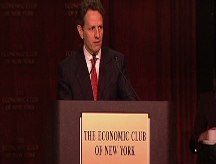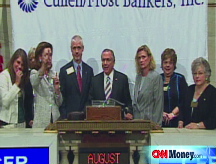T stands for TARP...and Trouble
The Treasury Department's capital purchase program of banks is now underway but there is mounting criticism of the plan from legislators and banks.
NEW YORK (CNNMoney.com) -- When the Treasury Department first unveiled its plan to buy stakes in banks last month, the move was heralded as a potential savior for fast-sinking banks and financial firms.
Now, critics of the proposal are growing by the day.
Legislators have been among the most vocal. Members of Congress, including House Financial Services Committee Chairman Barney Frank (D-Mass.), have expressed concern that banks may not necessarily use the government funds to make loans - a key selling point when the program was first pitched.
What's more, it is unclear if injecting capital into banks will even work. Banks remain skittish about doling out money after getting burned by the housing market collapse. And with the economy slowing, demand for both consumer and business loans is down, according to a Federal Reserve survey of senior loan officers published earlier this week.
But for all the jawboning that lawmakers do, whether banks lend or not will ultimately come down to how much pressure the federal agencies that oversee the industry, most notably Federal Deposit Insurance Corp. as well as the Office of Thrift Supervision, put on them, said Jack Murphy, a long-time partner at the law firm Cleary Gottlieb Steen & Hamilton.
"The real question is how much encouragement will bank regulators give banks to lend?" he said. "That is really the most direct influence you can have."
He believes the FDIC and OTS will urge banks and thrifts to make more loans but won't pressure them to lend just for the sake of lending.
"They will be encouraging banks to lend but they will also be very clear not to ask them to do any lending that won't fit their credit criteria," he said.
Yet, there has also been no shortage of criticism about the Treasury's Troubled Asset Relief Program, or TARP, from both the banking and securities industries.
A joint survey of more than 400 firms published Thursday by the Securities Industry and Financial Markets Association and four other trade groups revealed that a lack of clarity surrounding the program has dissuaded many firms from participating.
In particular, banks have expressed concerns about how vague the capital purchase portion of the program has been. The Treasury has a closely guarded process of picking which banks will get funds and which will not and some have argued that the government is effectively creating a group of so-called "winners" and "losers."
"The selection process is opaque and there are criticisms about that," said Bert Ely, a principal at Ely & Co., a financial institutions and monetary policy consulting firm in Virginia. "Some people would call this industrial planning."
But the complaints don't end there.
Other industry groups, including the American Bankers Association and the American Association of Bank Directors, have charged that the program allows Congress to change the terms of the agreement as they see fit in the future.
Theoretically, lawmakers could look to extract the proverbial pound of flesh from the banking industry months from now since they have the legal authority to mandate, say, higher dividend payments on preferred shares or some sort of loan quota.
A spokeswoman for the Treasury Department stressed that the terms of the capital purchase program are standard legal language. But some banks are already thinking twice about signing up for that reason alone, said David Baris, executive director of the American Association of Bank Directors.
"Congress can do anything they want," said Baris. "That concerns us."
To date, 49 financial firms have won either full or preliminary approval from the Treasury to get nearly $172 billion in government capital, according to analysts at Keefe, Bruyette & Woods.
That includes the original group of nine institutions that signed up for the program when it was first announced, big banks such as Citigroup (C, Fortune 500), Bank of America (BAC, Fortune 500), Morgan Stanley (MS, Fortune 500) and Goldman Sachs (GS, Fortune 500).
Before it is all said and done, Treasury plans to inject some $250 billion in capital into banks of all sizes across the country.
Some banks, such as San Antonio, Texas-based Cullen/Frost (CFR), have shunned the program altogether. But they appear to be the exception. Many other institutions are expected to queue up for cash before the Nov. 14 deadline.
There has also been talk that the capital purchase program could be extended to other participants, including insurance companies and other specialty financial services firms such as bond insurers, which got into trouble earlier this year. Even automakers have reportedly gone to the government with hat in hand seeking a part of the TARP pie.
Some industry experts have lambasted the Treasury Department for its seeming lack of focus.
"I don't think they have been projecting an image that they know what they are doing," said Mauro Guillen, a professor at the Wharton School of the University of Pennsylvania. "Quite frankly you have to be little more decisive."
But others contend that Treasury officials, including Secretary Henry Paulson, have been intentionally coy in order to allow themselves some latitude to react to the current crisis.
At the same time, there has also been speculation that agency officials have shown restraint in moving forward with the rescue plan because of this week's election and the eventual shakeup at the White House.
President-elect Barack Obama is expected to name a nominee for Paulson's successor soon, perhaps as early as Friday.
One lingering question, however, is when, and if, the original objective of TARP - purchasing troubled assets from banks in order to get them off their balance sheets - will return.
Treasury officials haven't given any indication that they have closed the book on that idea, although its launch has been bogged down by issues related to pricing and which banks get priority.
One method that the Treasury has suggested is the use of a reverse auction in which holders would put certain toxic assets up for sale and the government would buy those offered at the best price.
Cleary Gottlieb's Murphy was among those who said he anticipated the program to take root, but it was impossible to tell how soon it could happen.
"These things aren't simple," said "Treasury is in a position of trying to build a ship after it has set out for sea." ![]()



